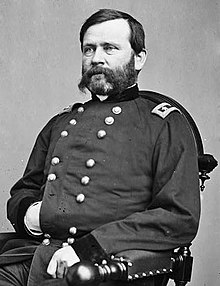William Buel Franklin
William Buel Franklin (born February 27, 1823 in York , Pennsylvania , † March 8, 1903 in Hartford , Connecticut ) was a major general of the Union Army in the Civil War .
Life
Franklin was born in York, Pennsylvania and graduated from the US Military Academy at West Point in 1843, top of his class. After that he went to the topographic engineers (military surveyors and cartographers). He served under Philip Kearny during the Mexican-American War and was promoted to first lieutenant during the Battle of Buena Vista . In 1859 he replaced Montgomery C. Meigs as supervising engineer in the construction of the dome of the US Capitol .
Soon after the Civil War began, he was made Brigadier General of the Volunteers. He rose from brigade commander to commanding general of the Potomac Army and took part in the Peninsula Campaign , the Battle of Antietam and the Battle of Fredericksburg . At Antietam was his VI. Corps in reserve, and he tried unsuccessfully to convince Major General Edwin Vose Sumner to allow his corps to exploit a weakened point in the middle of the Confederate lines. In Fredericksburg he commanded the Left Grand Division (with 2 corps under John F. Reynolds and William Farrar Smith ), which got stuck in their attacks on the Confederate right flank . His counterpart there was Lieutenant General Stonewall Jackson (CSA). Ambrose Burnside , the Commander-in-Chief of the Potomac Army and his superior, personally accused him of failure, even though he appeared to be carrying out his orders correctly. However, the attack on the right flank carried out by Franklin seems to have been more promising in hindsight than the attacks on the left flank ordered by Burnside afterwards, in which many brigades came into the murderous defensive fire of the well entrenched Confederate troops. In doing so, they had to overcome open terrain and suffered heavy losses.
After the defeat at Fredericksburg and the notorious mud march, the US army fermented with intrigue. Franklin was suspected of being the main initiator of a conspiracy against Burnside's leadership. In turn, Burnside caused Franklin considerable political trouble by making a damning testimony against him before the powerful Congressional Committee on Warfare. This kept him from serving in the field for months.
Franklin was again transferred to corps command in the Gulf of Mexico area, and in 1864 he participated in the failed Red River campaign . There he was wounded in the leg near Mansfield . On his return from the field, he was captured by Confederates who stopped his train near Washington, DC in July 1864 . But he managed to escape the following day. The remainder of his military career was limited by the handicap resulting from his wounding. It was also marred by a series of political and military failures. Despite the support of his friend and classmate at West Point Ulysses S. Grant, he was no longer given higher command.
After the Civil War, General Franklin moved to Connecticut and became the executive director of Colt Firearms Manufacturing Company. He later worked as the US General Commissioner for the Paris World's Fair in 1889. He died in Hartford and is buried near his birthplace in York.
literature
- Mark A. Snell: From First to Last: The Life of Major General William B. Franklin . New York, NY 2002.
Web links
- William B. Franklin in the database of Find a Grave (English)
| personal data | |
|---|---|
| SURNAME | Franklin, William Buel |
| BRIEF DESCRIPTION | General of the US Army |
| DATE OF BIRTH | February 27, 1823 |
| PLACE OF BIRTH | York , Pennsylvania |
| DATE OF DEATH | March 8, 1903 |
| Place of death | Hartford , Connecticut |
